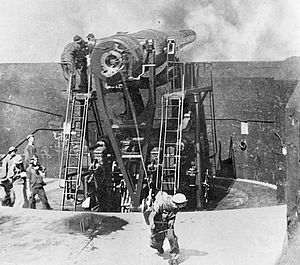12-inch gun M1895
| 12-inch gun M1895 | |
|---|---|

12-inch M1895 coastal defense gun being fired by lanyard
|
|
| Type | Coastal artillery |
| Place of origin | United States |
| Service history | |
| In service | 1895–1945 |
| Used by | United States Army |
| Wars | World War I, World War II |
| Production history | |
| Designer | Watervliet Arsenal |
| Designed | 1888 |
| Manufacturer | Watervliet Arsenal, Bethlehem Steel, possibly others |
| Variants | M1888, M1895, M1900 |
| Specifications | |
| Weight | 115,000 pounds (52,163 kilograms) (M1895) |
| Length | 442.56 inches (11.241 meters) |
| Barrel length | 35 calibers (442.56 inches; 11.241 meters) |
|
|
|
| Shell | separate loading, 975 pounds (442 kg) AP, 1,070 pounds (490 kg) AP shot & shell |
| Caliber | 12 in (305 mm) |
| Breech | Interrupted screw, De Bange type |
| Carriage | M1891 gun lift, M1892 or M1897 barbette, M1896, M1897 or M1901 disappearing, M1917 long-range barbette from 1920 |
| Traverse | disappearing: 170° (varied with emplacement), long-range M1917 barbette: 360° (145° casemated), railway: 10° |
| Maximum firing range | disappearing: 18,400 yards (16,800 m), long-range M1917 barbette: 30,100 yards (27,500 m), railway: 30,100 yards (27,500 m) |
| Feed system | hand |
The 12-inch coastal defense gun M1895 (305 mm) and its variants the M1888 and M1900 were large coastal artillery pieces installed to defend major American seaports between 1895 and 1945. For most of their history they were operated by the United States Army Coast Artillery Corps. Most were installed on disappearing carriages, with early installations on low-angle barbette mountings. From 1919, 19 long-range two-gun batteries were built using the M1895 on an M1917 long-range barbette carriage. Almost all of the weapons not in the Philippines were scrapped during and after World War II.
In 1885, William C. Endicott, President Grover Cleveland's secretary of war, was tasked with creating the Board of Fortifications to review seacoast defenses. The findings of the board illustrated a grim picture of existing defenses, and in its 1886 report recommended a massive $127 million construction program of breech-loading cannons, mortars, floating batteries, and submarine mines for some 29 locations on the US coastline. Most of the board's recommendations were implemented. Coast artillery fortifications built between 1885 and 1905 are often referred to as "Endicott Period" fortifications.
Watervliet Arsenal designed the gun and built the barrels. For several years, difficulties were encountered in building a disappearing carriage for the 12-inch gun. One alternative was the M1891 gun lift carriage, with the gun mounted on a large steam-powered elevator. Only one battery of this type was built, Battery Potter at Fort Hancock, New Jersey. When this proved to be too complex, guns were mounted on low-angle M1892 or M1897 barbette carriages. The M1897 carriage was actually an "altered gun lift" carriage, functionally equivalent to the barbette carriage. Eventually, the guns were mounted on M1896, M1897, or M1901 disappearing carriages designed by Bethlehem Steel; when the gun was fired, it dropped behind a concrete or earthen wall for protection from counter-battery fire. Bethlehem later built barrels as well.
...
Wikipedia
